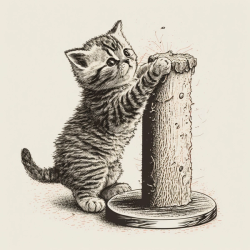Scratching at rough surfaces is a natural, ingrained behavior in cats. Although it is often misinterpreted as cats sharpening their nails, they are not creating a sharper surface, they are just getting rid of a duller one. This process frees the newer, healthier nail underneath. In addition, scratching is used as a form of territorial communication or marking. When the claws are scraped down a surface, the scent glands in their paws provide a visual and scent message to other cats. Scratching is excellent for stretching the muscles, tendons, and joints in a cat's toes, feet, legs, shoulders, and back. Any athlete can tell you that stretching before and after exercise helps to keep a body healthy and to protect it from injury during exercise - and it feels good! Last, but not least, scratching helps cats to express emotions, like excitement or stress.
We suggest the following methods to allow your cat to scratch and to prevent damage to your furnishings:
Redirect them to another target - a scratching post
If your cat is attracted to a sofa or upholstered chair, it is important to make sure that the scratching post you choose is equally solid and sturdy and offers a similar experience. Most cats prefer tall posts, but some cats prefer to scratch by lying down and pulling their body weight along the floor, causing damage to your carpeting. For those cats, you need horizontal scratching pads. If your cat has been scratching textured wallpaper at a certain height it is advisable that the alternative scratching area is vertical with similar texture and striations that allows the cat to stretch to the same level. Another critical factor to consider is texture. Some cats like the feeling of a carpet-covered scratching post, while others prefer sisal or cardboard. If space is an issue, then scratching panels can be fixed to walls using homemade or commercially available panels of sisal twine, bark, or corrugated cardboard. It may take some trial and error to determine what your cat loves, but it’s worth the effort.
It’s vital to place scratching posts in desirable locations. Placing a scratching post near the furniture that they have already been scratching is a smart idea because they will readily see it as a substitute. Be cognizant of the places where cats get the most attention (petting and cuddling and playing) from their owners. Those are the places that cats want to mark as their territory. Since cats usually want to scratch when they first wake up, it is also a good idea to place a scratching post or pad near their favorite napping spots. In multi-cat households, it is advisable to provide one scratching post per cat (plus an additional one as an option) positioned in various locations.
Guard your furniture with Sticky Paws or throw blankets
Sticky Paws is a double-sided tape that makes scratching feel less satisfying for many cats. Since it isn’t aesthetically pleasing for your furniture to be wrapped with tape, it is most often used as a training device until you have your cat trained to scratch in another place. Other options include throw blankets to protect a scratch-prone area; or wrapping a material such as sisal around the lower part of a chair or sofa to protect it.
Trim your cats nails / purchase cat nail caps
You should check your cat’s nails every couple of weeks and clip off the sharp tips; however, nail trimming does not entirely solve the problem, so you might want to consider buying Soft Paws which allow the cat to engage in normal scratching activities without causing destruction. Soft Paws are little caps that you put over a cat’s natural nails. They are inexpensive and they last from 4-6 weeks. A downside is that they can be cumbersome to apply.
Sacrifice a piece of furniture for the cat to use as a scratching post
When cats express a strong preference for a piece of furniture, it might be best for all concerned to simply allow the cat to use it; and, since it will become an eyesore, you can always move it into another room when you have company. If you choose to do that, there is a good chance that the cat will leave the rest of your furniture alone.
Never punish your cat
Punishment (yelling, hitting, shaking, spraying water, giving them time-outs) does not work. Cats will connect the punishment to the one who is doing the punishment rather than to their own behavior, so all they see and feel is their person being randomly mean to them. The result is a cat who is fearful and anxious and who will avoid its owner. Rewards are the only effective training methods. For instance, if you see your cat using the scratching post, wait until they are finishing scratching and then quickly give them a treat. Doing that will make them more likely to use the post again in the future.




